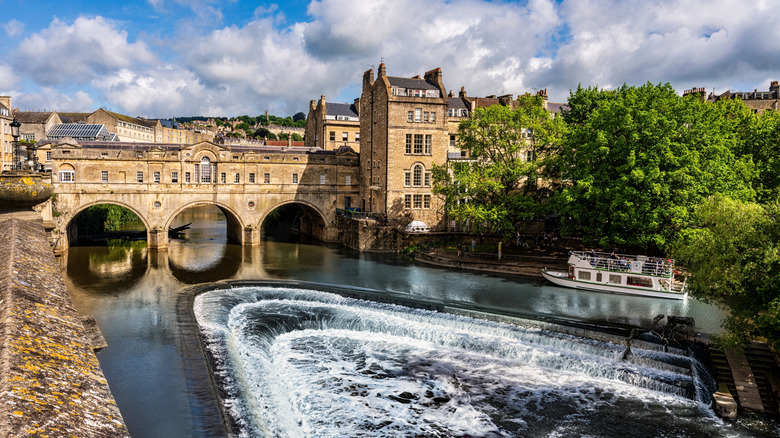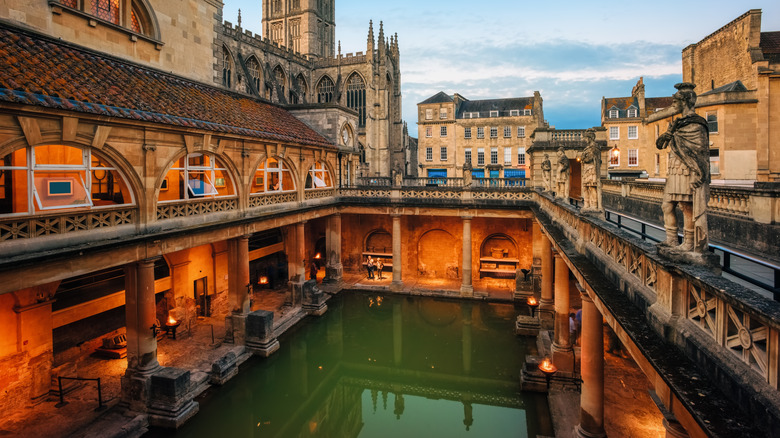The 'Best City Within Two Hours Of London' Is An Idyllic Gem With Stunning Architecture, Per Rick Steves
Nestled in a verdant corner of Somerset is the former Roman settlement once called Aquae Sulis, now known as Bath. Rick Steves called Bath the "best city within two hours of London" on his website. Bath's sights are manifold, but one of the highlights is the incredibly well-preserved, 2000-year-old Roman baths, from which the town takes its name. Just across the square, there's an impressive abbey church built between 1499 and 1616 on the ruins of a Norman cathedral. A short stroll away, the delightful Pulteney Bridge, crossing the River Avon, one of only a quartet of bridges in the world that are lined with shops on both sides.
Divert your attention away from these sights, though, and you'll find a honeycomb-colored Georgian old town, which Steves called "a triumph of the Neoclassical style," filled with stately buildings, world-class dining, and brilliant pubs. Steves suggests "to take the train from the airport to London's Paddington Station and then hop on a connection straight to Bath, rather than deal with London's intensity right off the bat." If you're arriving at Heathrow, then you can drive to Bath in just under two hours, or take the Heathrow Express, which takes around 15 minutes to London's Paddington to then jump on the direct train to Bath. This journey takes around 1 hour and 15 minutes, and benefits from a view-laden route through the English countryside.
A tour of Bath's honey-hued grandeur
The Roman Baths are one of Europe's best preserved Roman Bath complexes, with Roman-built paths leading visitors around the creamy jade-colored waters of the open-air Great Bath. There's a museum and a Roman temple dedicated to Sulis-Minerva, but if you want to dive into the restorative waters, you'll need to visit the modern Thermae Bath Spa, which has the added benefits of immersive city views from a rooftop pool. If you're traveling in the summer, consider visiting in the evening, when the Great Bath is evocatively illuminated with flickering torches. Next, take a look at the Bath Abbey, and don't neglect the interiors, which Rick Steves says "is lit with enough stained glass that it feels like the inside of a giant lantern."
While it was the Romans who founded Bath, it was the Georgians who gave it its iconic honey hues (from the local 160-million-year-old oolitic limestone). And the best example of Bath's Georgian architecture is the regal curve of houses that form the Royal Crescent, overlooking the Royal Victoria Park, so well preserved that it's been used as a romantic filming location. Nearby, you'll find another Georgian masterpiece in the Circus, a huge ring of Georgian mansions arranged as a circle via three equally-sized terraces, a formation said to be inspired by Rome's Colosseum.
While Bath has plenty of fine-dining restaurants, the food is at its best in the local eateries and pubs. For pub food with an elevated quality, try the excellent Chequers just north of the Royal Crescent, and for a hearty lunch, try a meat-filled sandwich or sausage roll at the wonderful Green Street Butchers.
Exploring the English countryside around Bath
To get close to the beautiful countryside enveloping Bath, it's as easy as walking along the centrally located Kennet and Avon Canal to what Rick Steves called "the sleepy village of Bathampton" where you'll find a charming village church, a couple of classic country pubs, and several boat tours. The best of the boats is the delightful Lady Lena, a rescued Victorian riverboat, owned and operated by a family who serve English tea during the tours, and you can take the boat for a guided tour along the canal in either direction between Bath and Bathampton.
Bath makes an excellent base from which to explore wonderful fairy tale villages like Castle Combe in the Cotswolds and for hikes in the picturesque Mendip Hills, a gorgeous landscape of limestone peaks and breathtaking gorges crisscrossed by walking trails. Those driving can reach Cotswolds' Castle Combe and Wiltshire's Lacock in less than an hour. But one of the most convenient trips by train is to the wonderful Wiltshire town of Bradford-on-Avon, which, with its leafy views of the river, antique architecture, and independent restaurants, is a little bit like Bath in miniature. You can reach Bradford on Avon from Bath in 11 minutes by direct train, but you can also walk the entire route along the Kennet and Avon Canal and Claverton Down in around three hours and 30 minutes.
If you don't feel like straying too far from Bath's lovely city center, head to Bathwick Hill to walk the Bath Skyline Walk. The walk is varied and brimming with breathtaking views of Bath's ornate topography and takes around four hours to complete. On the route, you'll pass sights like the 18th-century Sham Castle and stroll through ancient woodlands carpeted with wild garlic in the spring.


